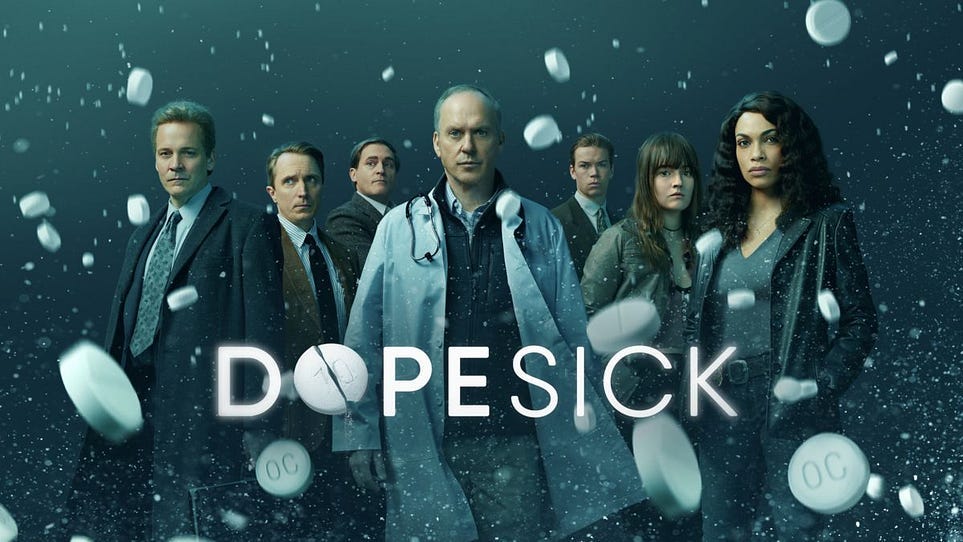Toward an Informed Consent Model for All Drugs
And yes, I do mean *all* drugs.

This piece originally was published to Medium in February of 2023. Why I am migrating my Medium Archive to Substack.
Hormone Replacement Therapy
It’s May of 2018, and I’m sitting on an examination table at Howard Brown Health Center’s TPAN location. My nurse practitioner, Jon, is a cheery, open-faced man with a trimmed grey beard. He’s sitting facing me, with a laptop at his side, and asking questions with a degree of patience and warmth that I’m not accustomed to in a medical provider.
“So you’re in today for a safe passage letter?” he asks.
A safe passage letter is a document provided by a physician to the court system, indicating that for the sake of a patient’s safety, the gender marker on their ID needs to be changed. I’ve asked for a safe passage letter so that I can change my legal gender to male.
“Yes,” I tell him. “But I was also thinking of starting low-dose testosterone.”
“We will get that letter ready for you today either way, that’s no problem,” he tells me, which is a relief. It turns out I don’t have to be on any kind of medical regime in order to legally transition. “And if you’ll just give me a moment, I’ll pull up some information about your options for low-dose T.”
My NP hands me a sheet of paper listing many of the effects a patient can typically expect when they take testosterone. Body hair growth, fat redistribution, thickening of the vocal chords, increased muscle tone, potential loss of periods. Some risks are listed as well: my blood pressure might increase, and I’ll be at an elevated risk of cardiac problems. I’ll have to monitor my levels with regular blood tests.
Jon talks through all of these bullet points with me, but I don’t have many questions for him, because I’ve been reading about T for years. After lots of research and deliberation, I know that I’m ready to give it a try. Jon doesn’t grill me, and he doesn’t doubt me on this.
“There’s just one thing,” I ask. “Will I have to do shots? I’d like to try Androgel, but I’ve heard it’s expensive.”
“Oh, we actually have a grant to help cover some of the costs of testosterone gel for our patients,” Jon tells me brightly. He pulls up a table showing how the expenses will break down. “You see here, if you went with testosterone shots, you would be paying about $12 for your prescription, but with our grant covering much of the cost, gel would only be a few dollars more, about $15.”
“That’s amazing!” I say, breathing out relief. I wasn’t sure I could handle taking T by needle. “I’ll take the gel then.”
“Great, I can call this in right now,” he tells me. By the end of the day I have both my first box of testosterone gel tubes and a safe passage letter in hand.
Howard Brown, like many health clinics in the United States, provides hormone replacement therapy under something called the informed consent model. (There are informed consent clinics in Australia, Spain, and Japan as well). Under the informed consent model, a patient does not need to prove that they’re sufficiently trans to a therapist or a clinician in order to transition. There is no requirement that trans patients live as their target gender for a year before beginning care, no subjecting patients to a battery of hard-to-score psychological tests and assessments, and no requiring trans people be sterilized in order to legally change their gender — all of which are demanded by most non-informed-consent countries.
Thanks to informed consent, I am not turned away from starting T just because I’m Autistic, or because I am gay, both of which are still treated as grounds to reject trans patients under other models of care pretty regularly. My transness is allowed to mean whatever I wish for it to mean. I’m not expected to meet or aspire to some external benchmark of masculinity, or to prove that dysphoria has left me sufficiently suicidal to warrant my receiving care.
Thanks to informed consent, I am simply trusted to know my own body, and to determine for myself what I need. My nurse practitioner is not there to decide what is best for me, or to limit which kinds of care I can access, only to inform me of the benefits and risk of my decisions, and help guide me through the process I’ve initiated. Under informed consent, I get to hold onto nearly all of my power and dignity. I am trusted as the authority on my own experience and feelings. I am informed, and the future of my body is in my own hands.
And I believe this is how it should be for all drugs.
Marijuana
It’s January of 2020, and I’m standing in line for the newly opened Dispensary 33 in Andersonville. Weed has just become legal in Illinois and a number of medical and recreational dispensaries have popped up all over my city. In Evanston, the city to the north of me, taxes on weed sales even partially go to reparations for the town’s longstanding Black residents.
Evanston, Illinois Will Use Weed Tax to Fund Nation's First Government Reparations Program
The City Council of Evanston, Illinois, a suburb of Chicago, approved what's believed to be the country's first…
Lots of people are caught up in the rush to buy legal weed for the first time in their lives, so the line for the dispensary is quite long. My friends and I stand in the rain and trade stories. Eventually, after about an hour and a half, we’re welcomed into the shop, a bright, cedar-trimmed space with illustrations of marijuana plants painted on the walls.
Budtenders in zip-up hoodies stand beside displays of wrapped chocolates and glass jars filled with flower. They hold iPads in their hands and ask if we have questions about the products. In every way it resembles and operates like an Apple Store. My friends and I roam the store with the polite awe of tourists in a museum.
I’m not a big weed aficionado at this point in time, but I know I want something gentle, and high in CBD. I ask a budtender for advice and he flicks through the menu on his screen.
“Would you like to start with edibles, or are you okay with vaping?” He asks.
“Oh, vaping please,” I tell him, knowing from past experience that edibles hit me far too intensely.
“Perfect. So for you, I would recommend trying the Cherry Limeade,” he points with his stylus to the image of a disposable vape on his screen. “37% THC, 49.9% CBD. It’s a hybrid of Indica and Sativa, so it shouldn’t leave you feeling too tired or too wired, unless you know that either of those don’t agree with you?”
I shake my head. Because I’ve only ever procured weed illegally before, I haven’t had much say over the types or the strains. Usually, I haven’t known anything about what I’m ingesting at all, having no choice but to trust whatever pot brownie or dusty bowl of stems is being handed to me.
“I don’t think I have a problem with Indica or Sativa,” I say.
“Perfect. Unless you have any other questions, this will be $57.90 plus taxes, cash only, and they can check you out at the counter.”
I pay for my weed, receive it all wrapped up in a crisp steel grey gift bag, and I take it home. Over the course of the next few months, I start experimenting with weed, and once delta 8 becomes legal to sell in head shops, I test out strains and learn even more. Slowly, I discover that marijuana reduces my sensory sensitivities and cools my racing thoughts, allowing me to enjoy parties and dancing at clubs far more easily. The right strain also helps me relax at the end of the day.
Unlike other medications, weed is provided not under a prescription model, but a dispensary one. No doctor or pharmacist is required to decide exactly which strain or dose is optimal for a patient. Even if someone is using marijuana for medical purposes, they are simply granted access to a whole host of options by being given a medical card — but it’s up to them as the consumer to determine which weed products are best for their body.
Thanks to the dispensary model, I can access the exact type of weed that I want to take, in whatever form and dosage is best for me. There is transparency about what each strain contains, and where it came from, and dispensary workers are well-trained on their many effects and there to answer my questions, so I’m able to make an educated choice.
Under the dispensary model, I don’t need to prove to a doctor that my sensory issues are bad enough that I deserve a marijuana prescription. I don’t have to battle with pharmaceutical staff or insurance providers to make sure my preferred type of treatment is covered. I can experiment, switch strains or ingestion methods, or go on a tolerance break at absolutely any time without penalty. I hold onto all the power and dignity. I am trusted as the authority on my own experience and feelings. I am informed, and the future of my body is in my own hands.
And I believe this is how it should be for all drugs.
UTI Medication
It’s July of 2021, and there is a painful burning between my legs. I have a urinary tract infection, and I know it, because I have had several of them before. I know all the risk factors, both generally and personally and so I can pinpoint the exact moment where I got it.
I’m trying to carry on with my life, but the pain is immense. I try doing some squats in the gym, but then have dash to the bathroom to dab off the blood emerging from my urethra. The stinging has grown and developed a heat. If I were to try and book a doctor’s appointment, I’d be waiting and aching for days.
Instead, I redownload the Lemonaid Health app and login. I pay $15 to virtually “see” a physician, and tell them through private messages that I have a UTI. I request a prescription of nitrofurantoin. My information is already on file from past visits, so the doctor can see I’ve had UTI’s before and that I’ve done well on that course of treatment. The doctors can also see that I’m trans, which helps them easily understand why I’m so prone to UTI’s while being legally male.
Within fifteen minutes, the request is approved and my prescription is sent off to the nearest pharmacy. I pop an antibiotic right on the salesfloor of the CVS and find almost immediate relief from the familiar hot stinging that’s so often my punishment for failing to pee after sex.
Thanks to patient-driven telehealth, I am not required to prove to doctors that I really am suffering from a type of infection I endure frequently and know well. I don’t have to jockey for time in a doctor’s office, or wait days to be seen treatment. I’m regarded with dignity by Lemonaid’s trans-competent staff and not gatekept because of the usual bureaucratic errors that keep men like me from being granted so-called “female” medical treatment. I hold onto nearly all the power and dignity. I am trusted as the authority on my own experience and feelings. I am informed, and the future of my body is in my own hands.
And I believe this is how it should be for all drugs.
The Mexican Model
Nearly all medications are available without a prescription in Mexico. There, pharmacies function very much like dispensaries do here in the United States: you simply present yourself and your medical complaint to a pharmacist, request the specific medication that you’d like (if you know what it is), and then you get it. It’s so easy and affordable that roughly one million Americans travel to Mexico to access healthcare each year.
The main drawback to the Mexican model as it’s currently practiced, according to empirical studies, is the lack of adequate training among the country’s medical providers. Some pharmacists in the country are unprepared to consult with their patients about a medication’s risks, contraindications, or its potential side effects. Others do not have the time or resources necessary to screen for potential risks associated with taking a particular medication, for example not gauging a patient’s blood clot risk before providing them with birth control.
As my own past experiences show, this downside is not inherent to an informed consent or dispensary style model. It’s a consequence of there not being enough well-trained pharmacists in the country, and of medical providers being so strapped for time that they can’t perform due dilligence when interacting with patients. In order for informed consent to function, patients have to be able to be informed.
If Mexico were to suddenly switch from its dispensary-esque model to one that required more medical appointments and gatekeeping on the part of physicians, the result would be fewer patients accessing the care they need, not more. The country reportedly has a deficit of over 150,000 doctors. Even still, under the current pharmaceutical model, patients from both Mexico and the U.S. are able to accessed needed medications far more quickly, and at a far lower expense, than they are in this country.
It’s clear the solution is to pour far more resources into training doctors and pharmacists, and to make advanced medical degrees attainable — not to walk away from a patient-driven model of care. Because by every other conceivable benchmark, the Mexican model outperforms ours.
Opioids
In Mexico, there is almost no occurrence of opioid addiction. While in the last few decades U.S. residents have suffered from a precipitous outbreak in opioid dependence, the only Mexican citizens who are at an increased risk of getting hooked on such drugs are those who did live in the U.S., and then were forcibly deported away from their families and homes.
Opioid painkillers were never pushed on patients in Mexico the way they were in Canada and the United States. Here, pharmaceutical representatives lobbied doctors heavily, misleading them about opioid painkillers’ side effects and downplaying their addictive properties. They used campaign donations and fake, astroterfed “patient advocacy groups” to ensure that their medications remained in strong legal standing no matter how many deaths they caused. And they rewarded physicians for prescribing opioids to patients, lavishing them with expensive gifts and travel packages.
Perspective | I was a drug rep. I know how pharma companies pushed opioids.
For every dollar the pharmaceutical industry spends on research and development, it spends two on marketing. When I…
Because of this multi-billion dollar industry and its seductive influence, pain sufferers in the United States were put on a course of treatment they didn’t fully understand the risks of, and therefore could not consent to. Numerous pain patients were pushed to take opioids when they’d never expressed any interest in the drugs at all.
Lobbying and mass misinformation of this kind was banned in Mexico. And to this day, Mexican patients and doctors alike have a negative attitude toward opioid medications, and view them as a last resort reserved only for the dying.
For decades now, American patients have not been in control of what happens to theirs bodies. For years, pain sufferers in the U.S. were pressured to take medications that were dangerous, without being informed of the risks. And today, now that the lethality of opioid addiction is well known, patients in pain struggle to receive any beneficial treatment at all.

Instead of having pills pushed on them as they were in the past, pain patients are now accused of being “drug seeking,” or viewed as overemphasizing their pain for manipulative purposes. Physicians gatekeep their access to beneficial treatments quite heavily, hoping to prevent future opioid addictions, but in doing so, they sometimes unwittingly drive patients to use illicit substances that are equally dangerous and not clearly tested or labeled.
At every turn, American patients in pain have been denied their power and dignity. They have not been trusted as the authority on their own experiences and feelings. They have not been well informed, and the future of their bodies was never in their own hands.
And I believe things should never be this way, not for any drug.
ADHD Medications
Far more people rely on ADHD-treating stimulant medication today than did just a few years ago. From 2006 to 2016, the number of stimulant prescriptions in the United States increased by 250%. In 2021, over 77 million prescriptions for ADHD medications were written in this country, up from 69 million the year before.
In numerous ways, the sharp uptick in ADHD medication prescriptions mirrors the increase in opioid prescriptions that came before it. Doctors have been heavily courted by the companies that produce ADHD medications, and encouraged to prescribe the drugs to patients freely. Lawmakers have also been targeted and wooed, ensuring that the stimulants can be advertised widely on a variety of platforms.
On social media apps like TikTok and Instagram, ADHD medications are promoted quite heavily with sponsored posts and influencer partnerships, many of which spread misinformation about the nature of the drugs, and about how ADHD functions. If you’ve ever heard the myth that ADHD drugs only “work” on people who have ADHD, congratulations, you have been on the receiving end of this mass misinformation campaign. It’s not true. Stimulants work on anyone with an operating nervous system. And ADHD is not a condition that can be biologically or chemically assessed — like most mental illnesses and disabilities, it’s diagnosed through interviews, and patient self-reports.
We Need Critical ADHD Studies Now
It’s time to move beyond the disorder/superpower binary.
Because of intentional mass misinformation and the untenable work demands the American labor force is facing, patients in this country have not been able to make an informed choice about their use of stimulants. As was the case with opioid just a few decades before, patients in the U.S. are now being pushed to take medications that they don’t fully understand the effects of, based on a pathology-based model of mental disability that is not supported by the science.
Unfortunately, the veritable explosion in ADHD medication prescriptions in recent years has also led to a nationwide shortage of those medications — and with it, the fear that patients’ access will begin being harshly gatekept. Just as happened with opioids, millions of patients with ADHD diagnoses were pushed to become reliant upon drugs they didn’t fully understand the dangers of, and then, once the medical system became aware of its failures, they were swiftly punished for it. It was never the patients who were really at fault. The true source of the problem was patients’ lack of autonomy — and their inability to provide true informed consent about what happened to their bodies.
When pain sufferers started being denied access to the opioids that doctors had gotten them hooked on, many had to switch to illegal, unregulated drugs instead. Patients with lapsed Oxycontin prescriptions had to resort to injecting heroin or taking fentanyl that they’d bought on the street, resulting in tens of thousands of preventable deaths each year. And decades of research already tells us that when ADHD patients can no longer benefit from taking their prescribed stimulants, they often resort to taking more potent, unregulated drugs such as cocaine instead.

Because drugs like heroin and cocaine are illegal, patients are not able to gauge how strong of a dose they are taking, nor are they able to confirm the drug really is what they think it is at all. And many pain sufferers and ADHD patient who resort to such under-the-table treatments would prefer not to be taking illict substances of unknown quality at all. But thanks to a variety of systemic failures across the medical system, they have been denied their power and dignity. They have not been trusted as the authority on their own experiences and feelings. They have not been well informed, and as a consequence, the future of their bodies is not in their own hands.
And I believe things should not ever be this way — not for any drug.
Cocaine and Fentanyl
My friend D brings fetanyl test strips with her to the club. D enjoys using substances like acid, marijuana, and mushrooms herself, so when she sees a gaggle of girls huddled up by the sink doing lines, she feels no judgement. But she’s also a working researcher with an expertise in public health, so she’s acutely aware of how plentiful fentanyl currently is the country’s illicit drug supply, and the risks that it carries.

Because of her familiarity with the research, D knows that liberatory harm reduction strategies work. Offering clean needles to heroin users and free condoms to sexually active people helps prevent the spread of HIV. Providing free COVID rapid tests arms the public with knowledge, which make it easier for them to make social plans responsibly. So when she sees club goers getting ready to use, D doesn’t scold or discourage them. She doesn’t report them, or try to take the drugs away, and she doesn’t assume she knows how their lives should be lived. She just offers them information, in the form of a small paper strip that produces one little pink line if it’s made contact with fentanyl, or two little pink lines if the sample is clean.
Thanks to D’s help, club-going cocaine users get to make safer, more educated determinations about what they are putting in their bodies. They are granted all of the power and dignity. They are trusted as the authorities on their experiences and feelings. They are well informed, and the future of their bodies is in their own hands.
And I believe this is how it should be with all drugs.



Dr. Price, you are on point as always! Great essay.
love love love this. As a chronically ill person with an illness doctors usually know nothing about, I am already directing so much of my own healthcare. Like you said, it has be involve being truly informed. I have a doctor willing to prescribe a lot of random stuff to see if it helps, but he does not adequately tell you the risks! anyway, i agree with this article so so much - most people don’t have access to such a doctor, and so many of my comrades would be so much better off if they could get their hands on the treatments they know can help.
it’s such a wonderful liberating vision. i’m gonna include it in my utopia!